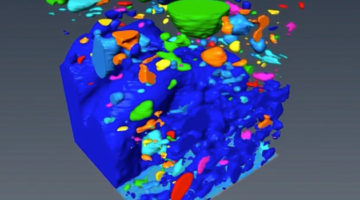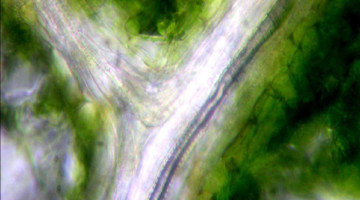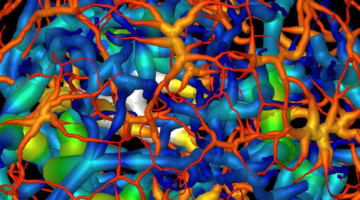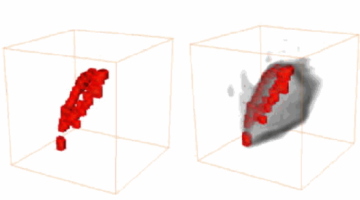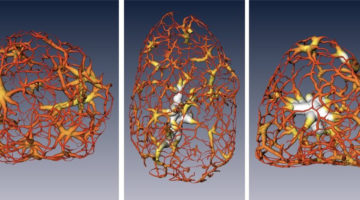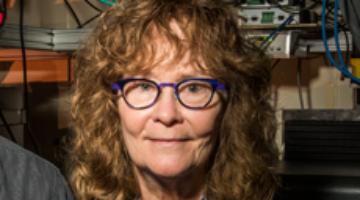Some rocks can float on water for years at a time before eventually sinking. X-ray microtomography studies help explain how by scanning samples of lightweight, glassy, and porous volcanic rocks known as pumice stones. Their surprisingly long-lived buoyancy can help scientists discover underwater volcano eruptions. Read more »
ALS Work Using Tomography
Tomography allows 3D imaging of structures inside samples without the need to physically slice them open. A series of images is collected as a sample is rotated, and the raw data is computationally converted into digital sections that can be stacked to reconstruct 3D visualizations of the sample. The very high flux of x-rays and infrared light at the ALS allows collection of high-quality, high-speed 3D images at nanometer or micrometer resolution. Synchrotron tomography also enables photon-energy tuning for element- and chemistry-specific contrast, as well as phase-contrast imaging.
Sequencing of Green Alga Genome Provides Blueprint to Advance Clean Energy, Bioproducts
Scientists have sequenced the genome of a green alga that has drawn commercial interest as a strong producer of quality lipids for biofuel production. The chromosome-assembly genome of Chromochloris zofingiensis provides a blueprint for new discoveries in sustainable biofuels, antioxidants, and other valuable bioproducts. Read more »
3D Visualization of Leaves during Drought
The veins of living leaves at increasing levels of drought stress were visualized using x-ray microtomography. The results expand our view of leaf drought responses, beyond the traditional embolism-centric view, to a broader focus on the role of the surrounding living tissues in water movement during drought. Read more »
GE Aviation Delves into Advanced Materials at the ALS
Developing ceramic matrix composites (CMCs) to replace the metal alloys traditionally used in jet engines has been a goal for the aviation industry for decades. For more than a year, GE Aviation has used the tomography capabilities at ALS Beamline 8.3.2 to gain insight into their CMC materials, guiding their engineering and design efforts. Read more »![]()
Mapping the Migration of Genetic Material
A powerful soft x-ray microscope captures tomographic images of the genetic material in the nuclei of nerve cells at different stages of maturity. The detailed 3D visualizations show an unexpected connectivity in the genetic material and provide a new understanding of a cell’s evolving architecture. Read more »![]()
![]()
When Rocket Science Meets X-Ray Science
Scientists at the Department of Energy’s Lawrence Berkeley National Laboratory (Berkeley Lab) and NASA are using x-rays to explore, via 3D visualizations, how the microscopic structures of spacecraft heat shield and parachute materials survive extreme temperatures and pressures, including simulated atmospheric entry conditions on Mars. Read more »
3D Visualization of the Behavior of Grease Additives
Lubricants help keep civilization running smoothly, but is there room for improvement? With the goal of increasing the life span and lowering the costs of all kinds of mechanical and biological systems, researchers used x-ray microtomography to visualize the behavior of grease additives under working conditions. Read more »
3-D Imaging Technique Maps Migration of DNA-carrying Material at the Center of Cells
Scientists have mapped the reorganization of genetic material that takes place when a stem cell matures into a nerve cell. Detailed 3-D visualizations show an unexpected connectivity in the genetic material in a cell’s nucleus, and provide a new understanding of a cell’s evolving architecture. Read more »
Molecular Switch Triggers Bacterial Pathogenicity
Using an array of high-powered x-ray imaging techniques at the ALS, scientists have revealed for the first time the molecular steps that turn on bacteria’s pathogenic genes. The study could open up new avenues in the development of drugs to prevent or treat bacterial infection. Read more »![]()
![]()
Getting to the Root of Grapevine Hydraulics
In grapevines, “root pressure” was assumed to play a role in recovering from embolisms (blockages) in a plant’s water-transport systems during drought conditions. To clarify this, researchers used ALS Beamline 8.3.2 to obtain 3D microtomographic images of grapevine stem segments detached from roots and leaves. Read more »
- « Previous Page
- 1
- …
- 4
- 5
- 6
- 7
- Next Page »
